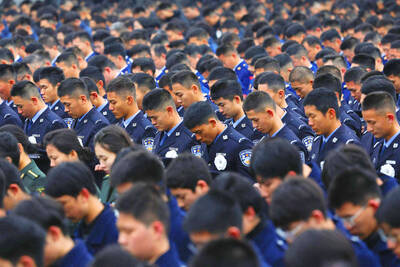In Chengdu, there is reportedly an ambitious plan afoot for replacing the city’s streetlights: boosting the glow of the real moon with that of a more powerful fake one.
The southwestern Chinese city plans to launch an illumination satellite in 2020.
The artificial moon is “designed to complement the moon at night,” though it would be eight times as bright, the People’s Daily reported.
The “dusk-like glow” of the satellite would be able to light an area with a diameter of 10km to 80km, while the precise illumination range could be controlled within tens of meters — enabling it to replace streetlights.
The vision was shared by Chengdu Aerospace Science and Technology Microelectronics System Research Institute Co (CASC) chairman Wu Chunfeng (武春風) at a national mass innovation and entrepreneurship event in Chengdu last week.
Wu reportedly said testing had begun on the satellite years ago and the technology had now evolved enough to allow for a launch in 2020.
It was not clear whether the plan had the backing of the Chengdu City Government or the Chinese government, although CASC is the main contractor for the Chinese space program.
The People’s Daily report credited the idea to “a French artist, who imagined hanging a necklace made of mirrors above the Earth which could reflect sunshine through the streets of Paris all year round.”
The likelihood of Chengdu’s fake moon rising remains to be seen, but there are precedents for the “moonage” daydream rooted in science, though the technology and ambitions differ.
In 2013, three large computer-controlled mirrors were installed above the Norwegian town of Rjukan to track the movement of the sun and reflect its rays down on the town square.
“Rjukan — or at least a small, but vital part of Rjukan — is no longer stuck where the sun don’t shine,” the Guardian reported at the time.
In the 1990s, a team of Russian astronomers and engineers succeeded in launching a satellite into space to deflect sunlight back to the Earth, briefly illuminating the night-time hemisphere.
The Znamya experiment was to “test the feasibility of illuminating points on Earth with light equivalent to that of several full moons,” the New York Times reported.
“Several” proved an overstatement, but the design was shown to be sound.
A more ambitious attempt, Znamya 2.5, was made in 1999, prompting preemptive concerns about light pollution disrupting nocturnal animals.
A German Ministry of Economics and Technology spokesman was less concerned, saying: “It’s a bit early for April Fool jokes, but this sounds like one.”
However, Znamya 2.5 misfired on launch and its creators failed to raise the funding for another attempt.
The People’s Daily was quick to reassure those concerned about the fake moon’s impact on nighttime wildlife.
It cited Harbin Institute of Technology Institute of Optics, School of Aerospace director Kang Weimin (康為民), who “explained that the light of the satellite is similar to a dusk-like glow, so it should not affect animals’ routines.”

China yesterday held a low-key memorial ceremony for the 1937 Nanjing Massacre, with Chinese President Xi Jinping (習近平) not attending, despite a diplomatic crisis between Beijing and Tokyo over Taiwan. Beijing has raged at Tokyo since Japanese Prime Minister Sanae Takaichi last month said that a hypothetical Chinese attack on Taiwan could trigger a military response from Japan. China and Japan have long sparred over their painful history. China consistently reminds its people of the 1937 Nanjing Massacre, in which it says Japanese troops killed 300,000 people in what was then its capital. A post-World War II Allied tribunal put the death toll

‘NO AMNESTY’: Tens of thousands of people joined the rally against a bill that would slash the former president’s prison term; President Lula has said he would veto the bill Tens of thousands of Brazilians on Sunday demonstrated against a bill that advanced in Congress this week that would reduce the time former president Jair Bolsonaro spends behind bars following his sentence of more than 27 years for attempting a coup. Protests took place in the capital, Brasilia, and in other major cities across the nation, including Sao Paulo, Florianopolis, Salvador and Recife. On Copacabana’s boardwalk in Rio de Janeiro, crowds composed of left-wing voters chanted “No amnesty” and “Out with Hugo Motta,” a reference to the speaker of the lower house, which approved the bill on Wednesday last week. It is

FALLEN: The nine soldiers who were killed while carrying out combat and engineering tasks in Russia were given the title of Hero of the Democratic People’s Republic of Korea North Korean leader Kim Jong-un attended a welcoming ceremony for an army engineering unit that had returned home after carrying out duties in Russia, North Korean state media KCNA reported on Saturday. In a speech carried by KCNA, Kim praised officers and soldiers of the 528th Regiment of Engineers of the Korean People’s Army (KPA) for “heroic” conduct and “mass heroism” in fulfilling orders issued by the ruling Workers’ Party of Korea during a 120-day overseas deployment. Video footage released by North Korea showed uniformed soldiers disembarking from an aircraft, Kim hugging a soldier seated in a wheelchair, and soldiers and officials

Cozy knits, sparkly bobbles and Santa hats were all the canine rage on Sunday, as hundreds of sausage dogs and their owners converged on central London for an annual parade and get-together. The dachshunds’ gathering in London’s Hyde Park came after a previous “Sausage Walk” planned for Halloween had to be postponed, because it had become so popular organizers needed to apply for an events licence. “It was going to be too much fun so they canceled it,” laughed Nicky Bailey, the owner of three sausage dogs: Una and her two 19-week-old puppies Ember and Finnegan, wearing matching red coats and silver